
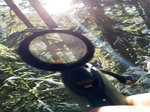



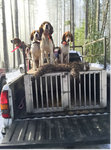



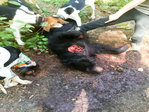


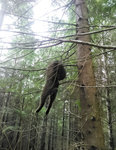
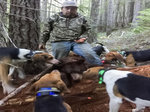
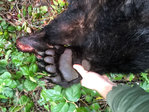
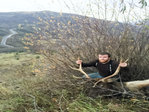
Editor’s Note: The following story is the latest in a series of articles detailing a massive poaching operation uncovered in Southwest Washington and Northwest Oregon. It comes after a records request that yielded hundreds of pages of evidence collected by the Washington Department of Fish and Wildlife.
Members of a prolific local wildlife poaching ring often treated their sordid endeavors as a familial bonding experience of sorts. Fathers and sons shared credit for illegal kills. Boyfriends brought their girlfriends along and showed them how to kill big game out of season and with the illegal help of hunting hounds.
In a number of cases, juvenile relatives were even brought along into the backwoods and allowed to not only observe, but take part in the unfettered, unethical killings of deer, elk, black bears, bobcats and cougars.
The Washington Department of Fish and Wildlife recently wrapped up the first leg of its investigation into the poaching and recommended seven people for more than 200 charges to the Skamania County prosecutor. It is unclear how many of those charges and suspects will wind up being prosecuted in court, but the mountain of evidence compiled by the WDFW is staggering. The WDFW says it has identified more than 10 suspects in total and expects additional charges to emerge from their cases as time goes on. For now though, the focus is on bringing justice to the most avid participants in the poaching activities that the WDFW says occurred between August 2015 and February 2017.
So far, at least 35 documented poaching trips have been submitted as evidence to support charges against the suspected poachers. In all, law enforcement officials believe the affiliated group of poachers could be responsible for the illegal killing of more than 100 animals, many of which were left behind to rot either fully intact or with just their trophy parts removed. The individuals facing charges at this time include Joseph Dills, 30, of Longview; Eddy Dills, 57, of Longview; William Haynes, 23, of Longview; Erik Christian Martin, 23, of Longview; and Bryan C. Tretiak, 31, of Morton. Aubri (Larsen) McKenna, 35, of Longview, and Sierra Dills, 17, of Longview, have also been referred for misdemeanor charges in Skamania County.
This isn’t the first time in hot water for several of the poaching suspects.
Joseph Dills, who now faces up to 64 charges, including four for first-degree unlawful big game hunting for the illegal use of dogs, pleaded guilty in Wahkiakum County District Court in 2008 to second-degree unlawful hunting of big game and second-degree criminal trespassing. Those decade-old convictions resulted from his involvement with the so-called “Kill ‘Em All Boyz,” another poaching ring based out of Cowlitz County. The ringleader of that group, Mike Gordon, was a nurse at Providence Centralia Hospital at the time and received a 13-month prison sentence for his violations.
During those criminal proceedings, Joseph Dills agreed to an interview with The Daily News of Longview and downplayed the severity of the actions of the group, insisting that Gordon bragged to an undercover WDFW agent about incidents that didn't actually take place.
“I’m not saying that we didn’t commit the crimes. But it was made to look like we were really, really bad people, and we’re not that way,” Dills told The Daily News at the time.
Ten years later and Dills finds himself at the center of controversy again, and this time he will likely be flanked by family and friends alike at the defendants table. That list of defendants will include his father Eddy Dills, who is accused of using his special access to Takhlakh Lake Campground to facilitate the illegal hunts deep in the heart of the Gifford Pinchot National Forest between Mount St. Helens and Mount Adams.
Investigative reports by the WDFW insist that Eddy Dills worked for Hoodoo Recreation as the campground host at Takhlakh Lake during the summers of 2015 and 2016 and that photographic evidence shows that he used his company-issued vehicle, complete with the Hoodoo Recreation emblem, to undertake numerous poaching excursions within the Gifford Pinchot National Forest.
A text message sent from Joseph Dills to William Haynes on March 31, 2016, seems to support that assertion. In that text message, Dills wrote, “My dad is gonna do that camp hosting again this year. He’ll be (at) Horseshoe or Takalak (sic). You ready for that again? All that death and caos? (sic)”
A text reply from Haynes’ cellphone read, “Oh f*** yeah. My dad said he wants to bring his trailer up there too this year.”
However, Hoodoo Recreation, which contracts with the U.S. Forest Service to bring services to campgrounds within national forests in Washington and Oregon, told The Chronicle that Eddy Dills was never an official employee. Instead, the company said that Eddy Dills’ wife, Angie Dills, was the person hired as campground host at Takhlakh Lake. Regardless, Kaly Harward, general manager of Hoodoo Recreation, admits that Eddy Dills was a regular presence at the campground and noted that there were several complaints against the couple on the books before Angie Dills was ultimately fired by Hoodoo Recreation earlier this summer.
Hoodoo Recreation representatives noted that a confrontation between the couple and a Forest Service employee in the summer of 2016 led to the Forest Service requesting that they be removed as campground hosts at Takhlakh Lake. Hoodoo responded to that request by moving Angie Dills to the Bumping Lake Campground northeast of Packwood. Things didn’t pan out for the pair there either.
“We received a complaint in about mid-July, in part because she was having Eddy in the campground and he was causing problems so we asked him to leave,” noted Harward. “When they became violent with one of our employees we called the sheriff.”
Harward noted that Angie Dills was permanently let go by Hoodoo around the beginning of August.
Harward said that while Hoodoo was aware that Eddy Dills was an avid hunter who owned a pack of hound dogs, the company had never heard allegations, or even rumors, of poaching activity emanating from their campgrounds.
“The only thing that I had every heard about poaching is a Forest Service employee said, ‘Well you know they have hounds and the only reason people in the mountains have hounds is for poaching,’” recalled Harward, who then asked for evidence of the misdeeds but was not provided with any.
“I can’t remove an employee on a stereotype,” reasoned Harward.
Harward said he wishes that law enforcement would have contacted his company during the investigation in order to alert them to their suspicions.
“My wish is that at some point during this investigation somebody from one of these institutions would have reached out to us and we would have removed them instantly. We take pride in being a steward of the forest and following the rules and following the law and providing the best atmosphere that we can,” said Harward.
The investigation into big game poaching in Washington’s wildlands actually began in Oregon, and the lynchpin to the whole house of cards was the illegal killing of a silver gray squirrel near The Dalles in November 2016. Wildlife officials in Oregon began receiving reports of poaching activities during the months of November and December in the area south of The Dalles in the evening shadow of Mount Hood. In an effort to figure out who was poaching buck deer and leaving their bodies behind to waste, law enforcement set up motion sensor trail cameras that eventually captured images of a truck belonging to one of the suspects making stops in the area in the wee hours of the morning and exiting the vehicle with spotlights and rifles on Nov. 30. Upon visiting the site, troopers found a deer carcass in the direction the individuals had walked off into the forest as well as deer hair near where the truck had been parked in the photo.
On Dec. 3, Oregon State Patrol officers on regular patrol observed the truck in The Dalles and executed a traffic stop. Erik Martin and William Haynes were inside the vehicle.
When asked about their involvement in the poaching incident on Nov. 30, both Haynes and Martin confessed to poaching two buck deer and a silver gray squirrel on that day. Haynes and Martin then agreed to have their cellphones searched by law enforcement. That’s when the full depth of their alleged depravity began to come into focus thanks to an extensive log of videos and photographs that showed dozens of illegal hunting expeditions in Oregon and Washington.
The WDFW was called to help with the investigation in Washington. That evening, a total of 20 unlawfully harvested deer heads, and one silver gray squirrel, were found by law enforcement at the residences of Martin and Haynes.
From that point, the testimony of Haynes, and the contents of both his and Martin’s phones, provided nearly all of the details wildlife officials needed to start connecting pieces of the vast poaching puzzle. Their phones contained a trove of data including phone records, text messages, photographs, videos and metadata, which allowed investigators to pinpoint the location of videos and photographs using GPS triangulation.
That oversight by the poachers to leave their location settings enabled on their phones was key to the investigation, said WDFW Sgt. Dan Rhoden, who noted that the suspects used an extensive knowledge of forest back roads to avoid detection during their killing sprees.
“They go up one way and they come out another and they’re jumping all around,” said Rhoden. “It’s easy for them to come in one way and go out another and jump around like that.”
During the investigation, WDFW police noted that U.S. Highway 12 in Lewis County was regularly used to access Forest Service roads that led to their favorite poaching grounds. The forest roads heading south out of Randle were noted as a particularly popular spot for the poachers to track and kill black bears with the illegal assistance of dogs.
In a statement provided to WDFW police officer Denis Budai by Haynes, he described how the group would regularly employ dogs to flush wildlife out of their preferred hiding places. Hunting bears, bobcats and cougars with dogs is illegal in Washington. Cats can be hunted with dogs in Oregon, but hunters must possess a furbearers license and report their harvest to state officials. None of the members of the poaching group possessed such a license.
“He indicated they drive around in trucks with dogs at the front of the truck and the dog box. He said the dogs then strike off the truck (pursue an animal). He said they usually take two or three trucks and they use radios to communicate between vehicles,” wrote Officer Budai.
Haynes also noted that the dogs were outfitted with GPS-equipped collars that allowed their owners to track their movements through the forest and ultimately find the animal that they’d been chasing. In one video obtained by the WDFW from Haynes’ cellphone, at least 11 dogs can be seen chewing on a bear that had been shot out of a tree in East Lewis County near Forest Service Road 2164. WDFW investigators were unable to tell if the bear was dead before the dogs began to tear it apart.
Haynes is currently looking at 61 charges that have been recommended by the WDFW, including 26 charges of first-degree illegal hunting of big game. He was previously convicted of second-degree unlawful hunting big game in Cowlitz County on October 3, 2013, which means that the new big game charges could be considered Class C felonies that carry a penalty of up to five years in jail and a $10,000 fine.
Martin does not have any previous wildlife related convictions but is currently looking at 28 charges of gross misdemeanor violations.